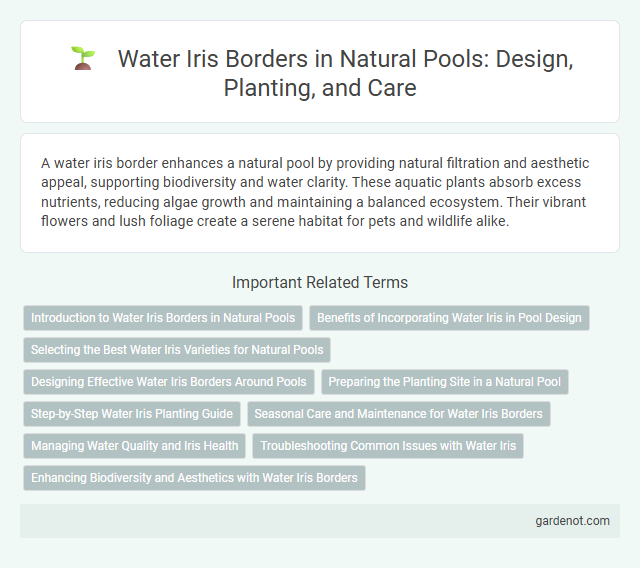A water iris border enhances a natural pool by providing natural filtration and aesthetic appeal, supporting biodiversity and water clarity. These aquatic plants absorb excess nutrients, reducing algae growth and maintaining a balanced ecosystem. Their vibrant flowers and lush foliage create a serene habitat for pets and wildlife alike.
Introduction to Water Iris Borders in Natural Pools
Water iris borders enhance natural pools by providing effective filtration and vibrant aesthetics. These plants thrive in shallow water, absorbing excess nutrients and improving water clarity while creating a habitat for beneficial wildlife. Incorporating water iris borders contributes to a balanced ecosystem, supporting the pool's ecological health and visual appeal.
Benefits of Incorporating Water Iris in Pool Design
Water iris enhances natural pool design by improving water quality through natural filtration, absorbing excess nutrients that help reduce algae growth. Its dense root system stabilizes the pool's edge, preventing soil erosion and providing habitat for beneficial aquatic life. Incorporating water iris also adds aesthetic appeal with vibrant blooms, promoting biodiversity and creating a balanced, eco-friendly aquatic environment.
Selecting the Best Water Iris Varieties for Natural Pools
Selecting the best water iris varieties for natural pools involves prioritizing species such as Iris laevigata, Iris ensata, and Iris pseudacorus known for their robust growth and purifying qualities. These water irises thrive in wet marginal zones, improve water quality by filtering nutrients, and enhance aquatic biodiversity. Incorporating diverse iris varieties with varying bloom times ensures year-round aesthetic appeal and habitat support in natural pool ecosystems.
Designing Effective Water Iris Borders Around Pools
Water iris borders create a natural, visually appealing edge around pools by combining functional water filtration with ornamental beauty. Designing effective water iris borders involves selecting species like Iris pseudacorus or Iris versicolor, which thrive in wet soil and help reduce algae growth. Incorporate varying heights and densities along the pool perimeter to enhance habitat diversity while maintaining clear swimming areas.
Preparing the Planting Site in a Natural Pool
Preparing the planting site for a water iris border in a natural pool requires selecting shallow areas with a depth of 15 to 30 cm, ensuring good water circulation and full sun exposure. The substrate should be nutrient-rich, using clay or loam mixed with aquatic planting media to anchor the iris rhizomes securely. Removing debris and controlling competing vegetation helps promote healthy growth and vibrant blooms throughout the growing season.
Step-by-Step Water Iris Planting Guide
Water iris planting transforms natural pool borders into vibrant ecosystems that enhance water quality and aesthetic appeal. Begin by selecting healthy water iris rhizomes and plant them in shallow water zones, ensuring they receive at least four to six hours of sunlight daily. Maintain consistent water levels and remove dead foliage regularly to promote vigorous growth and seasonal blooms.
Seasonal Care and Maintenance for Water Iris Borders
Water iris borders require seasonal care to maintain their vibrant growth and natural filtration abilities in a natural pool. In spring, trim dead foliage and divide crowded rhizomes to promote healthy development, while ensuring the water level supports root submersion without flooding. Autumn involves cutting back senescent leaves and protecting rhizomes from freezing temperatures by adding mulch or relocating pots to shallow water zones.
Managing Water Quality and Iris Health
Water iris borders play a vital role in natural pool ecosystems by improving water quality through nutrient absorption and providing habitat for beneficial microorganisms that break down pollutants. Proper management of iris health includes regular pruning to prevent overcrowding and monitoring water pH and nutrient levels to reduce algae growth. Maintaining a balanced water iris border ensures effective filtration, clear water, and a thriving aquatic environment.
Troubleshooting Common Issues with Water Iris
Water iris borders in natural pools often face challenges such as yellowing leaves caused by nutrient deficiencies, particularly low iron or nitrogen levels. Overcrowding can lead to poor water circulation, resulting in fungal infections or root rot that inhibit plant growth. Regularly monitoring water quality parameters and removing decayed foliage helps maintain a healthy water iris border and prevents common issues.
Enhancing Biodiversity and Aesthetics with Water Iris Borders
Water iris borders in natural pools create a rich habitat that supports diverse aquatic species, promoting ecological balance and natural filtration. Their vibrant blooms and delicate foliage enhance the visual appeal of the pool edge, blending seamlessly with native flora to create a lush, tranquil environment. These plants contribute to water purification by absorbing excess nutrients, reducing algae growth, and providing shelter for amphibians and beneficial insects.
Water iris border Infographic

 gardenot.com
gardenot.com